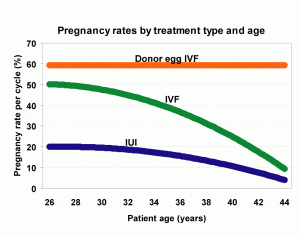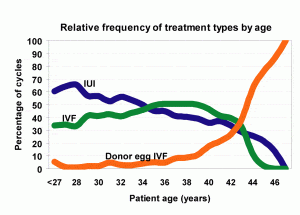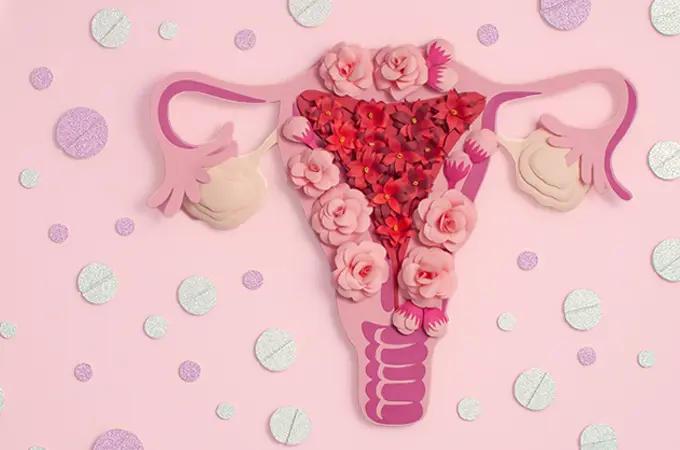Celebrity news and occasional stories about older first-time moms can make it seem like getting pregnant later in life is a possibility for everyone. The truth is that the media’s efforts at attracting readers’ attention can be misleading. The reality about fertility for the average woman is that it peaks in her 20’s. From that point, her fertile potential declines slowly as she enters her 30’s, and there’s abundant research to indicate that by age 45, most women are unable to conceive naturally.
Fortunately, today’s woman is increasingly savvy about fertility. Thanks to the Internet and numerous books by experts, women are learning about the optimal timing and treatments for fertility. They also know where to turn for hard facts that help make sense of sensational news items. One of the best sources is the Society for Assisted Reproductive Technology (SART), an organization that represents more than 85 percent of U.S. ART clinics. Each year, SART gathers data from its members on the type and number of in vitro fertilization (IVF) procedures performed and their outcomes.
Shady Grove Fertility is proud to maintain success rates that are consistently comparable or better than the national averages as reflected in SART’s most recently published data from 2005.
Specifically, Shady Grove Fertility’s percentages were better than the national average in the following areas:
- Pregnancies and live births to women aged younger than 35 to 40 years, using fewer than average fresh embryos from non-donor eggs. The results included significantly lower number of triplets or more, and a low twin rate that was comparable to national average.
- Live births to women ages 38 to 40 years old resulting from IVF with their own eggs, transferring fewer than average frozen/thawed embryos.
- Live births to women of all ages resulting from IVF with donor egg, using fewer than average fresh embryos.
Treatment Varies By Age and Diagnosis
The media can make it seem like IVF is the answer to all fertility problems. In fact, treatment options vary based on the patient’s particular cause of infertility, her age and health. IVF is indeed the most targeted treatment available with substantially higher pregnancy rates than intrauterine insemination (IUI). However, because IVF is more expensive and invasive than IUI, a younger woman’s typical treatment path may start with IUI and superovulation. Women in their 20’s and up to mid-30’s can see pregnancy rates as high as 20 percent per IUI cycle, again, depending on several variables. If several cycles are unsuccessful, the best option then may be IVF either with the patient’s own eggs or donor eggs, depending on several factors.

Because women who are older have statistically lower fertility rates, time becomes a more crucial issue. IVF is often therefore recommended earlier in the treatment journey. Additionally, rates of pregnancy from donor eggs are so much higher; it enables even women with little to no chance of pregnancy with their own eggs to finally achieve the longed-for experience. Shady Grove Fertility’s SART statistics demonstrate that live birth rates per embryo transfer can go from a low of 3.4 percent for women ages 43-44 (with their own eggs) to as high as 56.7 percent of embryo transfers in all age groups using donor egg.

The table to the right illustrates how the types of treatment used at Shady Grove Fertility vary with the patients’ ages. As women age, the use of IUI becomes less effective for achieving pregnancy. Most IVF cycles are used by patients in their mid to upper 30s, accounting for about half of the treatment cycles in this age range. In addition, women in their 40’s are more likely to use donor eggs rather than their own egg cells.
People who are anxious to become parents yet struggling to conceive are learning to resist believing everything they hear about sensational fertility news items. The facts alone about treatment are encouraging enough, especially when the data is specific to your clinic of choice. A woman’s age at onset of treatment remains one of the biggest factors in choosing which technique is optimal. Statistics can help you zero in on the providers with superior expertise in providing guidance on those choices.
Figure 1. Shady Grove Fertility 2002-2005 (10,490 IUI cycles and 10,039 IVF cycles, 2,548 Donor Cycles)
Figure 2. Percentage of IUI, IVF, and Donor Egg among all treatment cycles (22,987) according to patient age. Shady Grove Fertility 2002-2005





